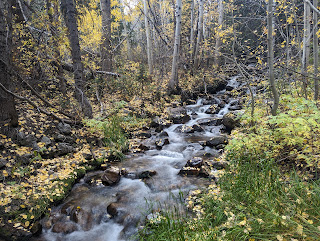Doug normally doesn't have too many travel destination requests. If there's a brewery stop in his future, he's a happy camper. So when he suggested that we plan our October travels around a celestial event, I made sure to take notice. Being able to observe an annular eclipse is a big deal for my star-gazing partner. Being able to observe it against the backdrop of the mountains of Great Basin National Park made it memorable for the both of us!
The journey here had been a tad bit stressful with our coolant leak issues, but fix #3 was currently still holding, so we felt confident driving two hours into the middle of nowhere to visit our 44th national park. Great Basin National Park derives its name from a huge geological area that encompasses most of Nevada. It's called the Great Basin because all the water in the streams and rivers of this area drain into shallow salt lakes, marshes, and mud flats rather than making their way to the ocean. These water reserves eventually evaporate into the dry desert air. Great Basin is one of the few national parks where you can experience both the hot desert and the cold alpine environment by just driving a half hour up the road from the Visitor Center.
And that was also where we found ...
alpine lakes,
and the national treasure that makes Great Basin such a special place ...
We found the home of the Bristlecone Pine!
The Bristlecone Pine is the oldest known living organism on our planet. Estimated to be between 3,000 and 5,000 years old, these gnarly-looking, hardy trees grow in the high elevations of the Great Basin mountains. They are accustomed to withstanding the bitterly cold temperatures and strong winds found in the high alpine environment.
Due to the strength of their ancient wood, even the ones that are considered ''dead'' will continue to stand upright and tall for 600+ years after the tree last sprouted green pine needles.
Oh, the stories that these ancient giants could tell us as we walked around their mountaintop grove.
Fortunately, the park service has done a good job of protecting, studying, and passing on the story of these masters of longevity.
Camping at 7,500 feet also has its challenges as we found out the following morning when we woke up to below freezing temps ... which is not-so-good for our external water pipes. Fortunately, we had no issues, but with even colder temps forecast for the following nights, we decided to go back down to ''desert level''. Great Basin National Park is surrounded by BLM (Bureau of Land Management) land which is essentially ''public'' land, so ... if you can get to it, you can camp on it. Doug found us a prime spot right next to an abandoned horse corral.
Loving our 200+ acre ''yard''!
The skies were clear on the morning of the much anticipated annular eclipse,
Baby Beest even got in on the act.
Enlarge the photo to see her ''ring of fire'' tattoo!
Our original travel route may have changed, but we were happy to find ourselves in the beautiful Nevada desert with its vast clear blue skies. Even though it was in the middle of nowhere, there is no eclipsing the natural beauty and amazing natural phenomenons found in Great Basin National Park!
Grateful also that some problems wait until we get back to civilization ...
Coolant leak #4 happened just as we pulled into the Arby's in Cedar City, Utah.
The belt from the Hymer-installed under hood generator once again wore a hole through the coolant hose. Thank God that there was a Napa Auto Parts store just down the street. Since he had been ''studying up'' on these coolant issues, Doug came to the rescue with a temporary fix that lasted until we could get to our trusted Hymer repair shop in California.
My hero earned his Arby's gyro!
Print this post

.jpg)

















(1).jpg)

No comments:
Post a Comment